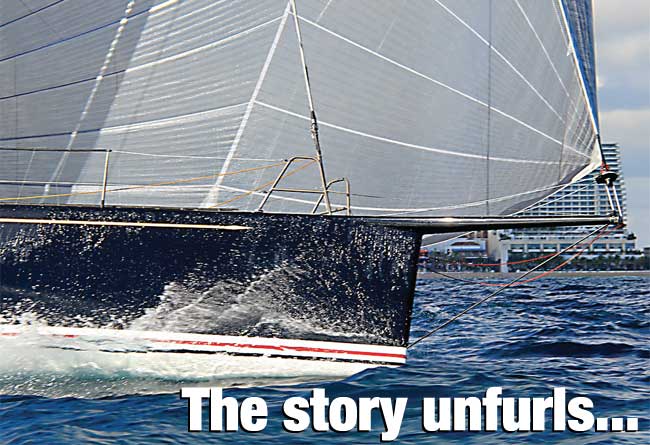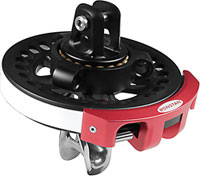

Ronstan Generation 2 furlers – designed from the top down
Ronstan’s next-generation furlers are the result of a complete rethink and redesign with top down furling applications foremost in our engineers’ minds during development. Effective and reliable top down furling relies heavily upon the use of the right torsional cable; while as well as the need for quality our engineers also found that it is largely a case of the bigger the cable diameter the better the furl.
To accommodate these larger furling cables, Ronstan fork attachments have been increased in both span and depth – which means the units will also accept the bigger thimbles which are becoming increasingly popular (Ronstan can also supply the latest FSE Robline GFL furling cable upon request).
Initially the Generation 2 furling units are available to suit three sizes of headstay with larger units to follow. The first three models are the Ø80mm (MWL 0.95 tonnes), Ø120mm (MWL 1.8 tonnes) and Ø160mm (MWL 3 tonnes) furlers. Ronstan’s new generation furlers are also available in standard configuration for those requiring traditional straight luff furling.

Ronstan’s well-proven larger S170R, S200, S200R, S280 furlers all continue to be available with top down attachments as required. The S200R top down furler has proved particularly effective – using a unique Torlon® roller bearing system in the floating collar to provide the highest maximum working load of any top down furler that is currently available in this size.
It is the S200R system that was chosen by current Mini Maxi world champions Bella Mente for their top down needs. Bella Mente bowman Sean Couvreux is well placed to comment: ‘Top down furling can be a finicky business... but with the proper gear and technique it makes sails that used to be risky to hoist much safer and easier to fly in big breeze,’ says Couvreux. ‘With bottom up furling I’d never hoist a Code 0 once the boat is on the wind. With top down, I’m happy to hoist the sail upwind – even in breeze – and without that dread of an accidental unfurl!’
The Ronstan top down collar employs a three-point lashing rather than a single point or two side-by-side ‘ears’. The Ronstan engineers have found this configuration ensures the collar bearings are more evenly loaded, providing better rotation. At the same time the offset nature of the three-point attachment keeps the attachment point clear of the torque line when furling – essential to a tight furl. If the tack of the sail becomes caught and joins in the furling too early the centre of the sail will never furl and the whole thing simply becomes an unholy mess.
As well as offering better performance, the new furlers from Ronstan offer a useful weight saving of around 40 per cent compared with their predecessors. The new furlers also incorporate a quick install feature for the furling line which finally does away with the need to remove pins or open up the rope guide itself.
Accessories available for the new furling system include thimbles, snapshackles, 2:1 leads, quick-release clevis pins, cotton reel-style lashing pins, as well as a useful screw-in furler plunger stop to prevent unwanted rotation.
It’s a sign of these progressive times that Ronstan is finding sales of top down furlers overtaking those of standard straight luff furlers. The advent of Code 0 sails using top down systems will only further increase the demand for these systems.
One advantage when using a top down Code 0 for race teams is that the furler can be pre-wound with around 10 full rotations before the Code 0 sheet is released. This technique delivers a powerful torsion effect to the head of the sail. Once the sheet is released the sail ‘sucks’ in rapidly and furling is swiftly completed – taking about half the time to furl compared with a standard system.
A typical Code 0 configuration sees the torsion cable running up the inside of a tubular luff ‘pocket’, with only the head of the sail directly fixed to the torque line via lashing at the top swivel. Torque transfer is aided by cotton reel-style lashing pins.
Having used top down furling offshore for the first time during the last Sydney-Hobart race, Ronstan’s Australian sales manager Peter Dowdney swears the new evolution in soft sail furling is the best thing to hit ocean racing since the introduction of the A-Sail. ‘In challenging conditions we enjoyed the most sensational run across Bass Strait on our Reichel-Pugh 66, regularly sitting on speeds in the high 20s and picking our way through shifts by gybing the boat regularly, and without hesitation,’ he says. ‘Normally in those conditions gybing can be stressful… And more often than not it means “all hands on deck”.
‘With top down furling gybing was a dream! You simply picked your wave, accelerated and as the boat surfed down the wave, furled up the kite and rotated the boat.
‘On the exit from the gybe you just haul on the sheet and unfurl the chute. If you do it right, the boat doesn’t even drop off the plane. Honestly, I never want to go ocean racing without a furling heavy air spinnaker again!’
Click here for more information on Ronstan »
We invite you to read on and find out for yourself why Seahorse is the most highly-rated source in the world for anyone who is serious about their racing.
To read on simply SIGN up NOW
Take advantage of our very best subscription offer or order a single copy of this issue of Seahorse.
Online at:
www.seahorse.co.uk/shop and use the code TECH20
Or for iPad simply download the Seahorse App at the iTunes store


